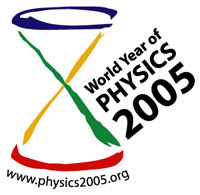
Newport News, Va. - This year marks the 100th anniversary of Albert Einstein's "miraculous year," in which he wrote five papers that changed the way we look at physics. The International Union of Pure and Applied Physics (IUPAP) and the United Nations Educational, Scientific and Cultural Organization (UNESCO) have declared 2005 the World Year of Physics, and the Department of Energy's Jefferson Lab is joining the international physics community in this celebration.
Einstein's ideas not only shaped the field of physics, they also made the research being conducted at Jefferson Lab possible. The Lab will celebrate the year with a number of events open to the public, including the biennial Open House, a World Year of Physics Lecture Series, public colloquia and other events to be announced as plans are finalized.
Current Schedule of JLab's 2005 World Year of Physics Events (as of Jan. 24, 2005)
February 8
From Slave to Scientist: A Dramatization of the Life of George Washington Carver
A Science Series Lecture
CEBAF Center Auditorium, beginning at 7 p.m.
This dramatization takes the audience through George Washington Carver's early struggles to get an education, his quest for a career as an artist, and his years as a teacher and inventor. The audience "meets" Dr. Carver during a concert tour. A gifted singer and pianist, he traveled throughout the South giving performances to raise money for Tuskegee Institute, where he taught and lived until the end of his life. From Slave to Scientist was written, produced, and directed by Robin Lane of Robin Lane Productions.
February 16
Orbiting the Sun with Qubits: An Overview of Science & Technology at the Applied Physics Laboratory
A World Year of Physics Colloquium by Victor McCrary, Johns Hopkins University
CEBAF Center Auditorium, beginning at 4 p.m.
In seven years, NASA plans to send a probe to orbit the sun. This probe will be subjected to a solar flux that will heat the probe's surface to temperatures in excess of 3500° F. In 10-20 years, the U.S. will have a quantum computer that can break any code or solve today's toughest gene sequence in fractions of the time it takes now. Challenges like these are being met by scientist and engineer investigators at the Johns Hopkins University Applied Physics Laboratory (JHU/APL). For over 60 years, JHU/APL has provided critical contributions in the areas of national defense, space science and exploration, and homeland security. This talk will provide an overview of basic and applied research projects that are poised to answer tomorrow's critical challenges through today's research.
March 16
Einstein's Biggest Blunder: A Cosmic Mystery Story
A World Year of Physics Series Lecture by Professor Lawrence Krauss, internationally known theoretical physicist from Case Western Reserve University and best-selling author
CEBAF Center Auditorium, beginning at 7 p.m.
Within a decade of adding a "Cosmological Constant" to his triumphant General Theory of Relativity in 1915, Einstein denigrated the addition as his "greatest blunder." In the last decade, however, new observations have led to a revolution in cosmology and a rethinking of Einstein's alleged blunder and its implications for understanding nature and life. In this World Year of Physics Lecture Series talk, Lawrence Krauss, director of the Center for Education and Research in Cosmology and Astrophysics at Case Western Reserve University, explains new data from a variety of independent cosmological and astrophysical observations and reveal the strangest theoretical possibility one can imagine.
March 22
A Visit with Marie Curie
A Science Series Lecture
CEBAF Center Auditorium, beginning at 7 p.m.
This one-woman, living history exposes the struggles and triumphs of Madame Marie Curie - an academically impassioned, vehemently private, fervently Polish scientist, mother and teacher. She was the first woman to receive a Nobel Prize when she and her husband, Pierre, earned the Nobel Prize in Physics in 1903. Then in 1911, Marie Curie became the first person to win a 2nd Nobel; this time the recognition was a Prize in Chemistry for her discovery of radium and radioactivity. This 40-minute presentation covers her childhood through scientific discovery, 10-minute Q&A with "Marie Curie" and then a 10-minute Q&A with the presenter. Visit the education web site for downloadable study guide. By Susan Marie Frontczak, Storysmith.
April 16
Jefferson Lab Open House
Free, public parking will be at Canon Virginia, 12000 Canon Blvd, Newport News, with free shuttle busses ferrying visitors to Jefferson Lab 9 a.m. to 2 p.m. (the last shuttle bus will bring guests on site promptly at 2 p.m. The last bus returning to Canon Virginia parking lot will depart JLab at 4 p.m.)
Bring the family, bring a friend and plan on spending the day with us! Take in the latest physics research and technology developments underway at Jefferson Lab. The Lab is opening its R&D areas, accelerator, experimental halls, and Free-Electron Laser. Hands-on activities from local museums, universities and federal agencies and cryogenic shows will show the public how nuclear physics impacts the lives of many.
The event will be free of charge, open to the public, and held rain or shine. Visiting the exhibits and facilities will take about two hours and involve a fair amount of walking.
For more information about Einstein's papers and how his scientific discoveries form the basis for the technologies used and the research conducted at Jefferson Lab, please visit www.jlab.org/.
For more information about events, please contact:
Linda Ware
ware@jlab.org
(757) 269-7689
Debbie Magaldi
magaldi@jlab.org
(757) 269-5102
Sarah Ingels
ingels@jlab.org
(757) 269-7444
Directions and Map
General Directions to Jefferson Lab
Site Map

